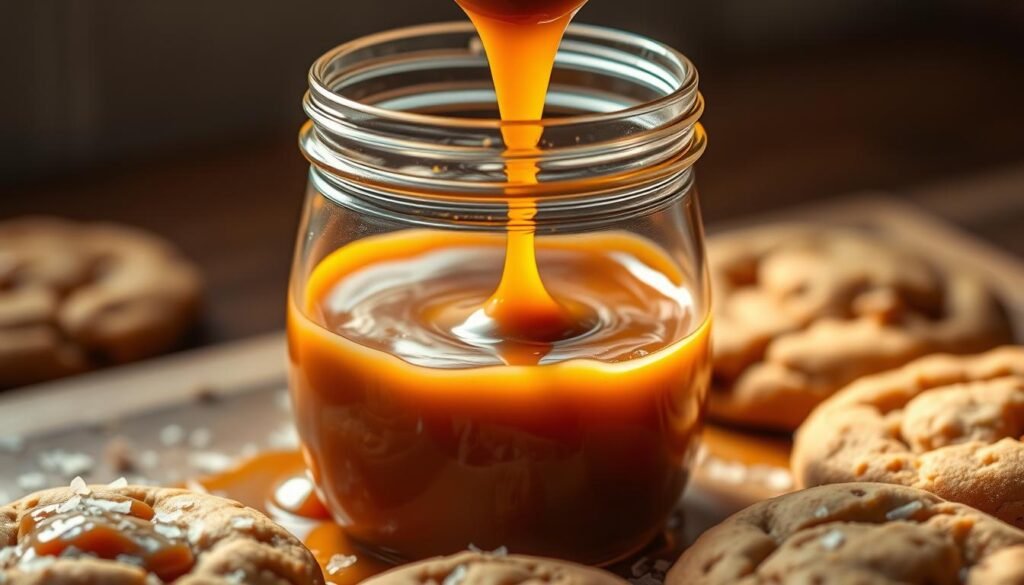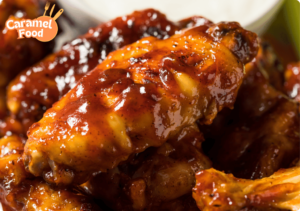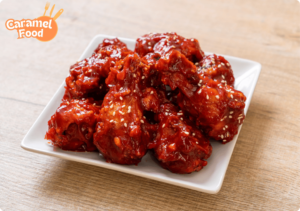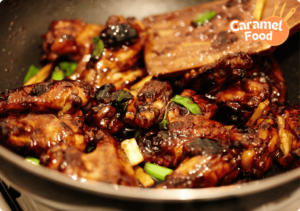Imagine the sweet smell of caramel filling your kitchen. It turns into a rich, golden treat. Making caramel at home is a joy, and it’s easier than you think. We’ll show you how to make perfect caramel every time.
Want to top your desserts with caramel or enjoy it with coffee? This guide has you covered. We’ll cover everything from ingredients to tools. You’ll be a caramel expert in no time.
A rich, glossy pool of homemade caramel sauce swirling in a glass jar, surrounded by scattered sea salt flakes, drizzled over freshly baked cookies, with warm, golden light illuminating the scene, creating an inviting and delicious atmosphere.
Key Takeaways
- Discover the simplicity of making caramel at home
- Learn the essential ingredients and equipment needed for perfect results
- Gain insights into the health benefits and cost savings of homemade caramel
- Master the step-by-step instructions for creating the perfect caramel sauce
- Explore creative ways to use your homemade caramel in a variety of desserts and drinks
Why Making Caramel at Home is Worth the Effort
Homemade caramel brings many benefits that make it worth the extra work. It’s healthier and can save you money. Making caramel at home is a rewarding experience.
Health Benefits of Homemade vs. Store-Bought
When you make homemade caramel, you control what goes into it. You can avoid additives and unhealthy sweeteners found in store-bought caramel. Homemade caramel uses simple, natural ingredients for a cleaner treat.
Cost Savings and Portion Control
Homemade caramel is also cheaper than buying it. You can make just the right amount you need. This cost-effective caramel lets you enjoy caramel without spending too much.
The perks of homemade caramel go beyond the joy of making it. It’s healthier and can save you money. The effort is worth it for a delicious, homemade caramel treat.
Essential Ingredients for Perfect Caramel
Making delicious homemade caramel needs a few key ingredients. At its core, sugar and cream are the main players. They combine to give caramel its unique flavor and smooth texture.
Sugar for caramel usually means white granulated sugar. But, some recipes might use brown sugar or mix both for a richer taste. The sugar type affects the caramel’s color and flavor.
Cream is also vital. Heavy or whipping cream is best because of its high fat content. This makes the caramel creamy and prevents it from becoming grainy.
Butter adds sweetness and a hint of saltiness. Other ingredients like vanilla extract, a pinch of salt, and sometimes water or lemon juice help control the caramel’s cooking.
Knowing how each ingredient works lets you tweak recipes to your liking. This way, you can make perfect homemade caramel every time.
Kitchen Tools and Equipment You’ll Need
Making delicious homemade caramel needs more than just the right ingredients. You also need the right kitchen tools and equipment. From basic essentials to advanced items, let’s look at the must-have tools for making caramel.
Must-Have Basic Tools
- Heavy-bottomed saucepan or pot: This is key for cooking your caramel. Choose one that heats evenly for consistent results.
- Candy thermometer: This tool is crucial for checking your caramel’s temperature. It helps you get the perfect caramelization.
- Wooden spoon or silicone spatula: These are great for stirring and scraping the pan’s sides. They help prevent burning.
- Baking sheet or silicone mat: Use these for pouring and cooling your caramel.
Optional Equipment for Advanced Techniques
If you want to try more advanced caramel-making techniques, consider these tools:
- Double boiler or bain-marie: These are good for slow, even heating when making caramel sauces or fillings.
- Offset spatula: This tool makes spreading and layering caramel smooth and easy.
- Caramel making tools and caramel equipment: Special tools like molds, dipping tools, and corkers can make your caramel creations better.
Safety Equipment Recommendations
Caramel-making can be tricky and hot, so safety gear is important:
- Heat-resistant gloves: Keep your hands safe when handling hot caramel or equipment.
- Candy thermometer: It helps you keep an eye on the temperature and avoid burns.
- Apron: It keeps your clothes clean and protects against hot sugar splashes.
With the right tools and practice, you’ll make perfect homemade caramel every time.
Caramel Recipe: Step-by-Step Instructions
Making caramel at home is a rewarding experience. It lets you create a versatile ingredient with a rich flavor. Follow these easy steps to make perfect caramel every time:
- Gather Your Ingredients: Get the needed items – sugar, water, butter, and cream or milk. Measure them precisely for consistent results.
- Heat the Sugar: In a heavy-bottomed saucepan, mix sugar and water. Heat it over medium-high, stirring occasionally, until it simmers.
- Monitor the Temperature: Cook the caramel without stirring until it reaches the right color and temperature. Watch the thermometer closely and remove the pan at the right moment.
- Add the Butter and Cream: When the caramel is golden brown, add the butter and cream or milk. Be careful, as it will bubble and steam a lot.
- Stir and Simmer: Stir the mixture gently until the butter and cream are fully incorporated. The caramel should be smooth and velvety.
- Cool and Enjoy: Put the caramel in a heat-safe container and let it cool completely. Then, use it in your favorite recipes or enjoy it on its own.
By following these caramel recipe steps, you can learn how to make caramel at home. You’ll master the caramel cooking process for delicious results every time.
| Ingredient | Amount |
|---|---|
| Granulated Sugar | 1 cup |
| Water | 1/4 cup |
| Unsalted Butter | 4 tablespoons |
| Heavy Cream or Milk | 1/2 cup |

A cozy kitchen scene with a wooden countertop, featuring a saucepan on a stove with melted sugar bubbling inside, surrounded by ingredients like butter, cream, and a pinch of salt, alongside measuring cups and a spoon, warm ambient lighting highlighting the rich golden color of caramel, with a few caramel candies scattered around for decoration.
A cozy kitchen scene with a wooden countertop, featuring a saucepan on a stove with melted sugar bubbling inside, surrounded by ingredients like butter, cream, and a pinch of salt, alongside measuring cups and a spoon, warm ambient lighting highlighting the rich golden color of caramel, with a few caramel candies scattered around for decoration.
Remember, the key to making perfect caramel is attention to detail and patience. By following these steps, you’ll create a delightful homemade caramel. It can elevate many sweet and savory dishes.
Common Mistakes to Avoid When Making Caramel
Making perfect caramel is a delicate art. With the right techniques, you can avoid common mistakes and get it right every time. Let’s look at the most common caramel mistakes, solve the problems, and help you achieve caramel perfection.
Temperature Control Issues
Keeping the right temperature is key when making caramel. If it’s too low, the sugar will take too long to caramelize, leading to a bitter taste. On the other hand, too high heat can make the caramel turn dark and bitter quickly. It’s important to monitor the temperature and adjust the heat as needed.
Crystallization Problems
One big problem with caramel is crystallization, which makes it grainy. This usually happens if you stir the caramel too much or if there are sugar crystals on the pan. To avoid this, don’t stir the caramel too much and make sure the pan is clean.
Timing and Color Guide
- Light caramel: 300°F (149°C) – This stage is perfect for drizzling over desserts or adding to coffee.
- Medium caramel: 320°F (160°C) – At this point, the caramel has a rich, nutty flavor that’s great for sauces and toppings.
- Dark caramel: 350°F (177°C) – The caramel is now a deep, mahogany color with a bolder, more intense flavor, ideal for baking and confections.
Remember, caramel troubleshooting is all about watching the temperature and looking for visual cues. With a bit of practice, you’ll make caramel that’s smooth, flavorful, and perfect for your dishes.
Storing and Preserving Your Homemade Caramel
Learning how to store and preserve caramel is key to enjoying your homemade treats for a long time. The right methods can keep your caramel fresh and ready for use in many recipes. This way, you can enjoy its sweet, buttery taste for weeks or even months.
Keeping caramel at the right temperature is crucial. It should be cool and consistent, away from heat or sunlight. The fridge is perfect for this, as it keeps the caramel from getting hard or crystallizing.
To store caramel in the fridge, use an airtight container or wrap it tightly in plastic. This keeps moisture in and prevents drying. For longer storage, freezing is a good option. Caramel can be frozen for up to 3 months, but thaw it slowly in the fridge before using.
Reheating caramel is easy but needs attention. Warm it gently over low heat, stirring constantly, until it’s right. Don’t use high heat, as it can burn or separate the caramel.
By following these tips, your caramel will stay rich and velvety for a long time. Enjoy the fruits of your labor, knowing your caramel is always ready to make any dish or dessert special.
Creative Ways to Use Your Caramel
Homemade caramel is a versatile ingredient. It can make many desserts, drinks, and gifts better. Whether you’re a seasoned baker or a mixology newbie, there are many ways to use this sweet sauce.
Dessert Applications
Caramel goes well with many classic desserts. You can drizzle it over ice cream or swirl it into cakes and pies. It’s also great as a filling for pastries.
For a stunning look, try caramel-filled chocolate truffles or layering it between pancakes or waffles.
Drink Enhancements
Caramel can make your favorite drinks richer. Stir it into coffee or hot chocolate for a cozy treat. Mixologists can use it to sweeten cocktails, like a salted caramel martini or caramel-infused old fashioned.
Gift-Giving Ideas
Homemade caramel is a thoughtful gift for any time. Package it in jars or tins. Add a personal touch with artisanal popcorn, fresh apples, or premium chocolates.
Caramel is also great for making homemade sauces, candies, and cookies or truffles.
Homemade caramel adds a rich, buttery flavor to many dishes and drinks. By trying these creative uses, you can impress your family and friends with your culinary skills.
| Dessert Applications | Drink Enhancements | Gift-Giving Ideas |
|---|---|---|
| Caramel-filled chocolatesCaramel-swirled cakes and piesCaramel-drizzled ice creamCaramel-layered pancakes and waffles | Caramel-infused coffee and hot chocolateSalted caramel martinisCaramel-sweetened old fashioned cocktails | Caramel sauces and candiesCaramel-filled cookies and trufflesCaramel-paired artisanal popcorn and fresh apples |
Troubleshooting Tips for Perfect Results
Making homemade caramel can be fun, but sometimes it doesn’t turn out right. Don’t worry! With a few easy tips, you can fix common problems and get that smooth caramel texture every time.
One big issue is grainy or crystallized caramel. This happens if the sugar doesn’t dissolve well or if the heat is too high. To fix caramel that’s grainy, heat it gently over low heat, stirring constantly, until the crystals melt.
Burning or scorching caramel is another problem. It can happen if it cooks too long or at too high a heat. If your caramel tastes bitter, don’t throw it away! Move it to a new pan, add a bit of water or cream, and heat it up again, stirring all the time, until it tastes better.
Another issue is when caramel separates. This usually happens if the temperature changes or if you add cold ingredients. To fix it, whisk the caramel over low heat until it becomes smooth again.
| Common Caramel Issues | Troubleshooting Solutions |
|---|---|
| Grainy or Crystallized Texture | Gently reheat over low heat, stirring constantly, until sugar crystals dissolve. |
| Burning or Scorching | Transfer to a new saucepan, add a splash of water or cream, and gently reheat, stirring continuously. |
| Separation | Whisk the caramel vigorously over low heat until the components recombine. |
With these troubleshooting tips for perfect caramel, you’ll soon be a pro at making homemade caramel. You’ll impress everyone with your sweet-making skills.

A visually appealing kitchen scene featuring a pot of golden caramel on a stove, with various troubleshooting items around it such as a thermometer, a bowl of water for testing, and a spoon. Include ingredients like sugar, butter, and cream in the background, with a slightly chaotic arrangement to suggest the process of experimenting. Soft, warm lighting to enhance the inviting atmosphere of homemade cooking.
Conclusion
We’ve looked into the many perks of making caramel at home. Using top-notch ingredients is healthier and saves money. Plus, you get to choose your flavors, making it a unique experience.
Whether you’re a pro in the kitchen or just starting, this guide has you covered. You’ll learn how to make perfect caramel every time. It’s all about following simple steps and using expert tips.
Making caramel at home is more than just a tasty treat. It’s about mastering a skill that can make your desserts and drinks special. You’ll avoid harmful additives found in store-bought caramel, making it a healthier choice for your loved ones.
So, why not try making this easy caramel recipe? Play with different flavors and uses to find your favorites. Homemade caramel brings joy and satisfaction, from start to finish. Dive into the world of caramel-making and explore endless culinary possibilities.
FAQ
What is the best way to store homemade caramel?
Store homemade caramel in an airtight container in the fridge for up to 2 weeks. For longer storage, freeze it for up to 3 months.
Can I use a different type of sugar to make caramel?
Yes, you can try different sugars like brown sugar or maple sugar for unique flavors. But, caramelizing might change a bit with each sugar.
How do I prevent my caramel from crystallizing?
To stop crystallization, don’t stir the caramel once it starts cooking. Use a clean brush to wipe down sugar crystals on the pan sides. Adding corn syrup or lemon juice can also help.
Can I add flavorings to my homemade caramel?
Absolutely! You can add flavors like vanilla, cinnamon, or sea salt to your caramel. Try different mixes to find your favorite.
What’s the best way to reheat hardened caramel?
To reheat hardened caramel, warm it over low heat, stirring constantly, until smooth. Or, place the container in hot water to soften it slowly.
How can I use homemade caramel in desserts?
Use homemade caramel in many desserts like drizzling it over ice cream or adding it to coffee. You can also layer it in cakes or pies, or dip fruit in it. The options are endless!
Can I substitute heavy cream with a different type of dairy?
While heavy cream is common for caramel, you can try milk or half-and-half. The taste and texture might vary, so adjust cooking time as needed.



